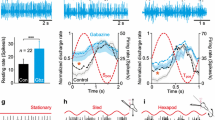Abstract
Vestibular information arising from rotational head movement and that from translational head movement are detected respectively by the semicircular canal and otolith organ in the inner ear. Spatiotemporal cues are in turn processed by the vestibulo-olivo-cerebellar pathway for sensorimotor coordination, but the role of the inferior olive (IO) in this pathway remains unclear. To address whether rotational and translational movements are differentially represented in the IO, we studied the distribution pattern of IO neurons recruited into the circuitry following selective activation of receptor hair cells of the horizontal semicircular canal or the utricle in adult rats. Neurons in the beta nucleus of IO (IOβ) and dorso-medial cell column of IO were responsive to horizontal translation, but not rotation. Notably, otolith-related neurons were observable largely in the rostral IOβ. In contrast, the subnucleus A of IO (IOA), subnucleus C of IO (IOC), and dorsal cap of Kooy (IOK) were responsive to horizontal rotation, but not translation. In the IOA, these canal-related neurons were clustered in the medial portion of the subnucleus. In the IOC, canal-related neurons were skewed towards the rostral half. In the IOK, canal-related neurons were found throughout the subnucleus. These indicate that the distributions of canal- and otolith-related neurons encoding horizontal motions are clearly segregated in the IO. These discrete IO subnuclei therefore provide a topographic map for temporal and adaptive operations of sensorimotor coordination and spatial reference.
Similar content being viewed by others
References
Gerrits NM, Voogd J, Magras IN. Vestibular afferents of the inferior olive and the vestibulo-olivo-cerebellar climbing fiber pathway to the flocculus in the cat. Brain Res. 1985;332:325–36.
Sugihara I, Wu HS, Shinoda Y. The entire trajectories of single olivocerebellar axons in the cerebellar cortex and their contribution to cerebellar compartmentalization. J Neurosci. 2001;21:7715–23.
Ito M. The molecular organization of cerebellar long-term depression. Nat Rev Neurosci. 2002;3:896–902.
Angelaki DE, Cullen KE. Vestibular system: the many facets of a multimodal sense. Annu Rev Neurosci. 2008;31:125–50.
Lai CH, Yiu CN, Lai SK, Ng KP, Shum DK, Chan YS. Maturation of canal-related brainstem neurons in the detection of horizontal angular acceleration in rats. J Comp Neurol. 2010;518:1742–63.
Ma CW, Lai CH, Lai SK, Tse YC, Yung KK, Shum DK, Chan YS. Developmental distribution of vestibular nuclear neurons responsive to different speeds of horizontal translation. Brain Res. 2010;1326:62–7.
Li C, Han L, Ma CW, Lai SK, Lai CH, Shum DK, Chan YS. Maturation profile of inferior olivary neurons expressing ionotropic glutamate receptors in rats: role in coding linear accelerations. Brain Struct Funct. 2012. doi:10.1007/s00429-012-0432-3.
Gustave Dit Duflo S, Gestreau C, Lacour M. Fos expression in the rat brain after exposure to gravito-inertial force changes. Brain Res. 2000;861:333–44.
Saint-Cyr JA, Courville J. Projection from the vestibular nuclei to the inferior olive in the cat: an autoradiographic and horseradish peroxidase study. Brain Res. 1979;165:189–200.
Barmack NH, Fredette BJ, Mugnaini E. Parasolitary nucleus: a source of GABAergic vestibular information to the inferior olive of rat and rabbit. J Comp Neurol. 1998;392:352–72.
Barmack NH, Yakhnitsa V. Vestibular signals in the parasolitary nucleus. J Neurophysiol. 2000;83:3559–69.
Barmack NH, Yakhnitsa V. Vestibularly evoked climbing-fiber responses modulate simple spikes in rabbit cerebellar Purkinje neurons. Ann N Y Acad Sci. 2002;978:237–54.
De Zeeuw CI, Wentzel P, Mugnaini E. Fine structure of the dorsal cap of the inferior olive and its GABAergic and non-GABAergic input from the nucleus prepositus hypoglossi in rat and rabbit. J Comp Neurol. 1993;327:63–82.
Schonewille M, Luo C, Ruigrok TJ, Voogd J, Schmolesky MT, Rutteman M, Hoebeek FE, De Jeu MT, De Zeeuw CI. Zonal organization of the mouse flocculus: physiology, input, and output. J Comp Neurol. 2006;497:670–82.
Voogd J, Schraa-Tam CK, van der Geest JN, De Zeeuw CI. Visuomotor cerebellum in human and nonhuman primates. Cerebellum. 2012;11:392–410.
Acknowledgments
This work was supported by GRF grants of the Hong Kong Research Grants Council (HKU 761409M, 761710M, and 761711M).
Conflict of interest
There are no current or potential conflicts of interest for the five authors, Drs. Chun-Wai Ma, Chun-Hong Lai, Billy K.C. Chow, Daisy K.Y. Shum, and Ying-Shing Chan.
Author information
Authors and Affiliations
Corresponding author
Rights and permissions
About this article
Cite this article
Ma, CW., Lai, CH., Chow, B.K.C. et al. Topography of Inferior Olivary Neurons that Encode Canal and Otolith Inputs. Cerebellum 12, 322–324 (2013). https://doi.org/10.1007/s12311-012-0438-7
Published:
Issue Date:
DOI: https://doi.org/10.1007/s12311-012-0438-7




